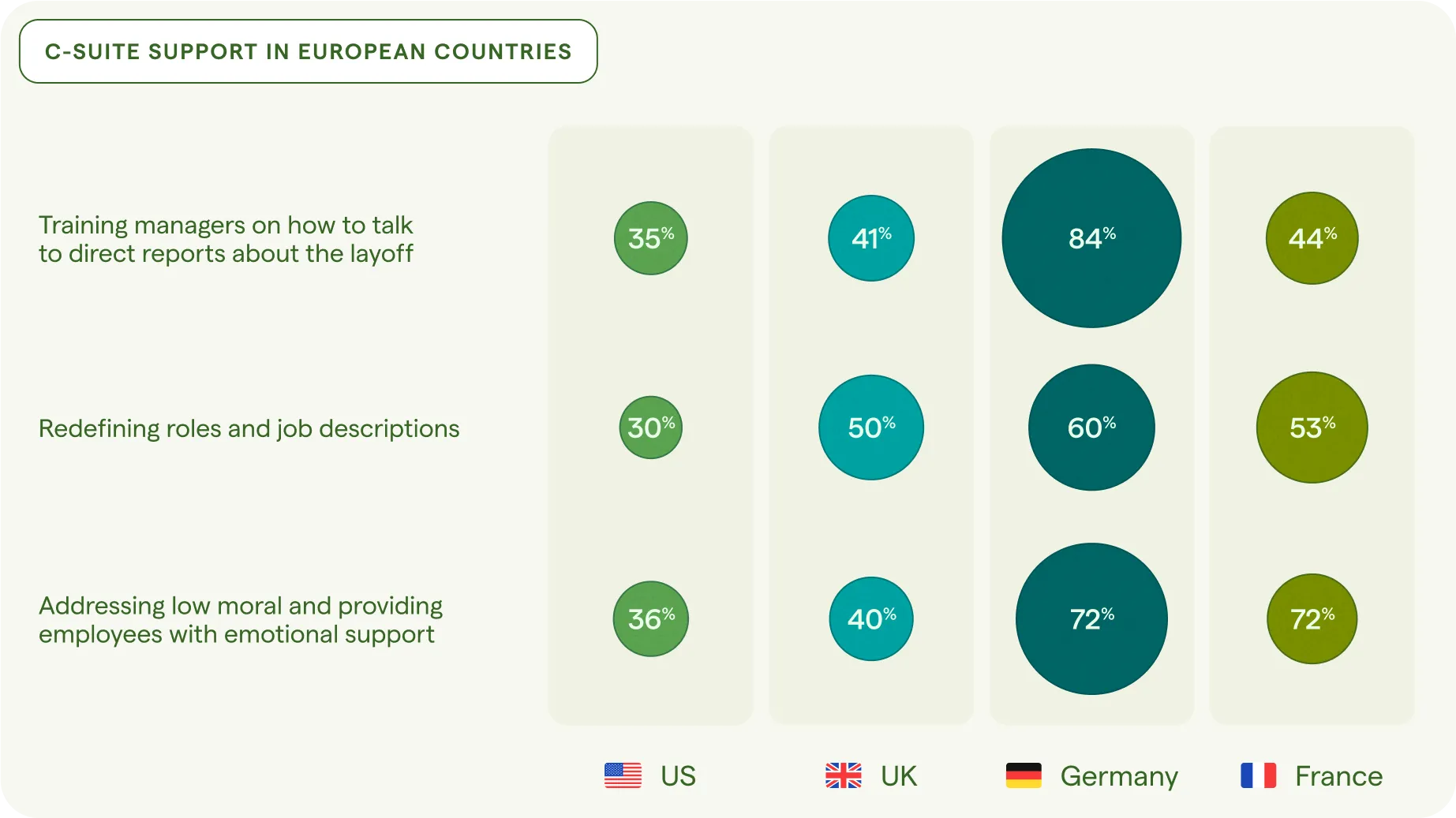From Google to Amazon, mass layoffs have been a common theme all year long. Faced with market uncertainty, companies everywhere have been letting staff go. The tech industry alone saw more than 240,000 jobs lost globally in 2023 — over 50% more than in 2022. But the losses haven’t stopped there, with layoffs happening across industries.
That has all put HR departments in the hot seat. Stuck between employees’ fears and executives’ demands, people teams have found themselves faced with added responsibilities and emotional labor that can last long after the pink slips are handed out.
In our 2024 State of People Strategy Report, we wanted to find out whether layoffs are as far-reaching as the headlines lead us to believe. And if they are, how are organizations handling them? Are HR leaders getting any support to help their remaining employees through these difficult times?
Let’s take a look at the results — and see how organizations could be doing better.
A Year of Layoffs
Based on survey responses from 1,052 HR professionals from around the world, Lattice’s 2024 State of People Strategy Report — now available — covers some of the biggest topics in HR today. This year, that meant examining layoffs and how they’re affecting HR teams and the employees they represent.
As it turns out, layoffs were as prevalent in 2023 as the media suggests.
Over the past 12 months, 41% of the companies we surveyed have laid off employees. The size of those layoffs varied from less than 5% of the workforce to more than 21%. They were prevalent across organizations of all sizes.
Thankfully, though, HR leaders expect those numbers to reverse themselves in the year ahead.
About 60% of the HR professionals we surveyed expect their headcount to grow over the next twelve months, with as many as 15% of them expecting a period of rapid or hyper-growth. And this is true even for many of those companies that did not have any layoffs this year.

In the meantime, though, there’s another problem HR teams are facing, as many find themselves handling these rounds of layoffs without the support they need from their C-suite.
The Disconnect Between HR and C-Suite Teams
What this year’s survey made clear is that a disconnect exists between HR leaders and their C-suite executives. And this is making it more difficult for HR departments to support employees through the layoffs that are taking place.
For proof, just look at how long each believes it should take for remaining employees to bounce back after a layoff.
- For HR leaders, the overwhelming consensus (64%) is that it takes between four months and a year for employee morale and productivity to return to normal.
- According to HR leaders, most of the C-suite (66%) have a different opinion, expecting a full recovery from a layoff in just three months or less.

HR leaders may believe that their C-suite counterparts don’t fully understand employees’ feelings during the post-layoff period. Empathy is particularly critical during these times of turmoil, as remaining employees worry about the state of their jobs, the extra work they’ll be tasked with, and how they’ll fit into this newly pared-down organization.
Without that empathy at the executive level, HR is left navigating those emotions alone, trying to fill the gaps and instill a company culture of support that builds continued engagement. All of which is critical if the organization hopes to thrive after these times of disruption.
“A positive culture directly impacts employee retention, engagement, and productivity,” said Donald Knight, CPO of Greenhouse. “It's concerning if the C-suite doesn't recognize this.”
The Biggest Post-Layoff Challenges Faced by HR
To see what can happen when the C-suite aligns with HR, just look at the highest-performing teams we surveyed. The HR teams that are meeting and exceeding their goals are significantly more likely to receive support from their C-suite — showing how much that alignment can help HR teams thrive.

European HR teams — which report higher employee engagement and are slightly more likely than US teams to feel like they are meeting or exceeding their goals — are also less likely to say they get little to no support from the C-suite during a layoff.

“It’s important to remember that HR is fundamentally an enabling function,” said Gianna Driver, chief human resources officer at Exabeam. “[You] help others to achieve their goals, both on your team and across the organization. Ultimately, our goal should be to enable employees to succeed — and when employees succeed, our company succeeds.”
Without C-suite support, though, it becomes harder for HR to achieve that goal.
Yet from the perspective of most HR teams, the C-suite is active only in communicating the reasons for a layoff and how it will unfold to remaining employees (60% of HR professionals say they are supported or very supported in this way). HR leaders also say executives underdeliver when it comes to addressing low morale (41%), training supervisors and managers to talk to their direct reports (38%), and redefining roles and job descriptions (37%).
This leaves HR teams on their own when it comes to providing this kind of support. They’re left out on a limb as they try to navigate the different needs and challenges of their organization.
After all, the challenges HR managers face aren’t the same across the board. While low morale and engagement were challenges for 67% of respondents, for instance, a layoff is more likely to affect employee morale in a smaller company than a larger one. Since the teams are smaller, employees are more likely to know the individuals who were laid off.
Larger companies, on the other hand, face more challenges around reassigning jobs and tasks — something only 29% of all respondents are concerned about.
As they try to navigate these needs without support from higher-ups, HR doesn’t just risk falling short on their goals — their own mental health and wellbeing can be affected too. While layoffs can be an emotional drain for any people team, this year’s survey shows that a lack of alignment with C-suite executives in general can leave HR overwhelmed and burnt out, less engaged with their jobs, and more worried about their job security or that of their team.

Supporting Employees Through a Layoff
“People leaders shouldn’t be afraid to have — and share — strong opinions around their people strategies and the ways in which they will support overall business growth, both within their organization and the board room,” Driver said.
For many HR managers, that means asking the C-suite for support as they establish programs that will help employees in the aftermath of a layoff. Without C-suite backing, HR leaders may not have the resources available to put post-layoff programs into place to keep their employees engaged.
To support these programs, the C-suite could do the following:
1. Share the news company-wide.
Clear communication through a layoff is a critical first step to helping your organization in the aftermath — yet 46% of survey respondents find that communicating why layoffs are happening is a challenge. With leadership support, though, the communication process can go more smoothly.
Ideally, the C-suite should be intricately involved with helping to:
- Communicate the reasons for the layoff. In a company-wide all-hands meeting, for instance, leaders can dispel any confusion caused by word-of-mouth rumors.
- Encourage transparency. By sharing as much as possible throughout the organization, HR and their executive teams can help ease remaining employees’ fears.
- Keep lines of communication open. Encouraging questions and regular employee check-ins and truly listening to employees’ concerns will help validate their feelings and let teams know exactly what further support is required.
2. Train managers to talk to their direct reports.
Low morale following a layoff is to be expected, but it can also make it more difficult to retain remaining talent — especially the high performers. It’s no wonder, then, that 55% of survey respondents consider retaining top talent after a layoff a challenge.
By helping to support employees, allocating resources, and championing people programs, the C-suite can help HR leaders mitigate this by training managers to:
- Answer the tough questions. Managers who know how to address their direct reports’ questions can be the first line of defense in dulling the negative impacts of layoffs.
- Be empathetic. Empathy can be taught, and by teaching managers how to best handle the negative emotions around layoffs, HR can help teams navigate survivor’s guilt that can arise during the layoff process, helping to improve their overall emotional wellness.
3. Provide employees with emotional support resources.
Emotional support resources and employee assistance programs are another way of helping employees through their negative feelings after a layoff, supporting your remaining staff’s overall wellbeing during the transition.
Leaders can aid these types of initiatives by encouraging:
- Employee wellbeing surveys. Surveys can help determine how employees are feeling and where support may be required.
- Stay interviews. By interviewing top talent, you can identify their primary concerns and sense of job security, ensuring they remain engaged and secure in their position.
4. Redefine roles and job descriptions.
Over half (58%) of survey respondents found it challenging to manage the remaining employees’ workloads post-layoff. Yet those remaining employees want to know who will take on the work of their former colleagues. Leaving these questions unanswered risks fanning feelings of insecurity and resentment — or can lead to burnout as remaining team members try to fill the gaps.
Leadership and HR can work together to help mitigate these feelings by:
- Rewriting job descriptions. By rewriting job descriptions and redefining roles, you add clarity and open communication around new responsibilities and career development paths.
- Using change management surveys. A change management survey can help organizations get a better reading of how employees are feeling about the changes underway.
—
Unfortunately, laying off employees isn’t always avoidable. Yet those layoffs can have a negative impact throughout the entire organization — especially when they’re mishandled.
For HR, it’s important to ensure these challenging times are handled in the best way possible. But that’s harder to accomplish without leadership support.
By supporting people programs and leading with empathy, the C-suite can empower HR to better identify and build out the resources required to ease remaining employees through these times of change. Without that alignment, HR can find themselves out on a limb — exhausting their own emotional resources to help employees through.
So while layoffs may be impossible to avoid, it is possible to get through them intact. For that to happen, though, HR can’t take it all on alone.
To explore more insights, read Lattice’s 2024 State of People Strategy Report.








